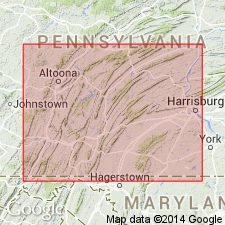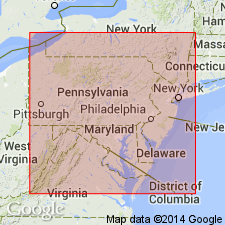
- Usage in publication:
-
- Byers Island Member
- Modifications:
-
- Named
- Dominant lithology:
-
- Limestone
- AAPG geologic province:
-
- Appalachian basin
Summary:
Byers Island is here named the lowest member of Keyser Formation. Unit is characterized by its nodular beds. 93 ft thick at type locality north of Selinsgrove, PA. It can be traced from central PA southward into WV and VA. Grades laterally into the Tonoloway Limestone in PA, the Big Mountain Shale Member in WV, and then into the Clifton Forge Sandstone Member in VA. Underlies Jersey Shore Limestone Member (new). Age is Late Silurian.
Source: GNU records (USGS DDS-6; Reston GNULEX).

- Usage in publication:
-
- Byers Island Member*
- Modifications:
-
- Overview
- Areal extent
- AAPG geologic province:
-
- Appalachian basin
Summary:
The Byers Island Member of the Keyser Limestone of Head (1972) is here accepted for USGS use in PA, VA, and WV. Overlies Tonoloway Limestone; underlies Jersey Shore Member of the Keyser. Age is Late Silurian.
Source: GNU records (USGS DDS-6; Reston GNULEX).
For more information, please contact Nancy Stamm, Geologic Names Committee Secretary.
Asterisk (*) indicates published by U.S. Geological Survey authors.
"No current usage" (†) implies that a name has been abandoned or has fallen into disuse. Former usage and, if known, replacement name given in parentheses ( ).
Slash (/) indicates name conflicts with nomenclatural guidelines (CSN, 1933; ACSN, 1961, 1970; NACSN, 1983, 2005, 2021). May be explained within brackets ([ ]).

